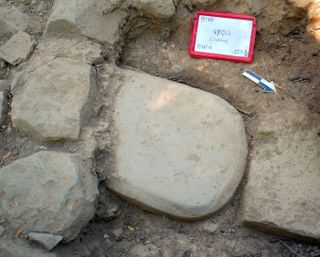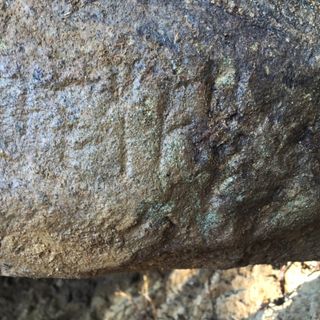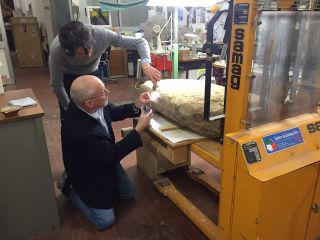'Extraordinary Find': Rare Religious Text Written in Lost Etruscan Language

A newly unearthed stone slab from Tuscany bears a rare Etruscan religious text that may reveal how early members of this theocratic society worshipped.
And it's written in a language that went out of use some 2,500 years ago, archaeologists said.
The slab was found in the last week of the last planned field season at Poggio Colla, a site in Italy that archaeologists have been excavating for 21 years. It dates back to the sixth century B.C. and weighs around 500 pounds (227 kilograms). Made of sandstone, the slab measures 4 feet tall and 2 feet wide (1.2 by 0.6 meters), and is chiseled with a lengthy inscription.
"It's going to take months, if not years, of probably some rather heated discussion among experts to unravel the text," said Gregory Warden, an archaeologist at Franklin University Switzerland and the principal investigator of the Mugello Valley Archaeology Project, where the Poggio Colla excavations take place. But both the slab's context — it was found at the foot of a temple — and a preliminary look at its contents, suggest that it is religious in nature.
Lost civilization
The Etruscans flourished in what is today northern and eastern Italy, starting around 700 B.C. They had a major influence on Roman culture and religion, and were absorbed by Rome by about 500 B.C. Much of their language is known from short funerary inscriptions on graves, but few longer texts survive, Warden told Live Science. One exception is a linen book written in Etruscan that somehow made its way to Egypt and was turned into a mummy wrapping. [Photos: The Tomb of an Etruscan Prince]

That makes the new text exciting. The slab was found in the foundations of a temple dated to 500 B.C., meaning it could shed light on the worship of gods. Though much is known about the Etruscan polytheistic religion — which had deities equivalent to the Greek and Roman gods — little is known about the gods or goddesses worshipped at the Poggio Colla site.
Sign up for the Live Science daily newsletter now
Get the world’s most fascinating discoveries delivered straight to your inbox.
The slab could also reveal another view of the religious rituals the culture practiced. Etruscans were known even by contemporary historians as extremely religious, and were described as obsessed with rituals, Ward said.
The Poggio Colla sanctuary has turned up remarkable ritual material over the years, Warden said. The oldest representation of childbirth in Western art was found there, depicting the head of a baby emerging from the body of a squatting woman, possibly a goddess.
"What I'm hoping is that this inscription will provide a different view of what is going on there," Warden said.
"Extraordinary find"
Archaeologists just finished cleaning the new slab last week, and now will begin the painstaking process of identifying every letter. Translation may prove challenging, as there will likely be many words on the slab that haven't been seen since the Etruscan language fell out of use.

"Even making out the letters is not easy," Ward said. "It's carved in sandstone, and it's worn and abraded."
The researchers are taking photographs of the slab to apply photogrammetry, a method of turning 2D images into 3D models. They're also using lasers to scan the slab's surface. The plan is to make that data available so that anyone interested could 3D-print a copy of the slab for study.
"A text of this kind, where the Etruscans speak for themselves, is really an extraordinary find," Warden said.
Follow Stephanie Pappas on Twitter and Google+. Follow us @livescience, Facebook & Google+. Original article on Live Science.

Stephanie Pappas is a contributing writer for Live Science, covering topics ranging from geoscience to archaeology to the human brain and behavior. She was previously a senior writer for Live Science but is now a freelancer based in Denver, Colorado, and regularly contributes to Scientific American and The Monitor, the monthly magazine of the American Psychological Association. Stephanie received a bachelor's degree in psychology from the University of South Carolina and a graduate certificate in science communication from the University of California, Santa Cruz.
Most Popular

